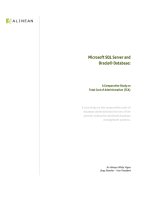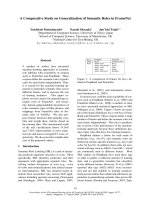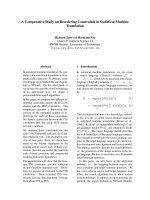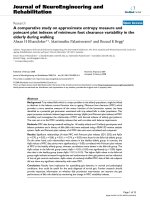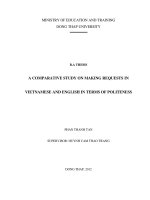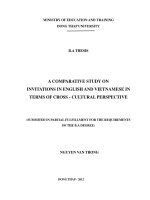A COMPARATIVE STUDY ON MAKING INVITATION IN ENGLISH AND VIETNAMESE IN TERMS OF CROSSCULTURAL PERSPECTIVE
Bạn đang xem bản rút gọn của tài liệu. Xem và tải ngay bản đầy đủ của tài liệu tại đây (234.81 KB, 43 trang )
HANOI OPEN UNIVERSITY
FACULTY OF ENGLISH
GRADUATION THESIS
A COMPARATIVE STUDY
ON MAKING INVITATION IN ENGLISH AND VIETNAMESE
IN TERMS OF CROSS-CULTURAL PERSPECTIVE
Supervisor: M.A Nguyễn Văn Quang
Name of student: Đinh Phương Thúy
Date of birth: 26/01/1991
Class: K17A5 (2010-2014)
Hanoi 2014
DECLARATION
I hereby declare that this thesis is my own work and effort and that it has not
been submitted anywhere for. Where other sources of information has been
used, they have been acknowledges.
Hanoi, 4 May 2014
Student
Supervisor
ACKNOWLEGDEMENT
I must offer my profoundest gratitude to my thesis advisor, M.A Nguyen Van
Quang. Form finding an appreciate subject in the beginning to the process of
writing thesis, M.A Nguyen Van Quang offers his unreserved help and guidance
and lead me to finish my thesis step by step. Without his kind and patient
instruction, it is impossible for me to finish my thesis.
I am also indebted to my friends, who squeeze time from their busy schedule to
help me finish my thesis, they are all busy with their own thesis but they are
willing to give their helping hands as soon as I am in need.
Finally, I am grateful to my parents and my sisters who always support me
spiritually throughout my life and provide a carefree environment for me, so
that I can concentrate on my study. I am so lucky to be one of my family’s
members.
PART A: INTRODUCTION
1.
Rationale
There is no doubt that today mastering a language is very necessary because it
can give learners important opportunities to communicate to study and work
effectively abroad. It is very difficult to master a foreign language because the
enormous vocabulary and profound understanding in grammar are not enough.
So it is necessary for learners to understand the culture of the language that they
want to master. Let take English and Vietnamese as an example. There are
differences in the use of language between English and Vietnamese. To learn a
language means to learn the culture of the country where the language is
spoken. This can help learners to master this language as well as immerse in to
the culture and daily life the target language to comprehend that language.
Acquiring a second language demands more than learning new words and
another system of grammar (Levine and Adelman, 1982). The goal of
learning language nowadays is to be able to have effective communication with
native speakers. However, communication can fail to achieve as the
misunderstanding of the country’s culture. The good knowledge of the country’s
culture can helps learners to interact well with the people in the native country
where the language is widely spoken. As a result, it is very difficult to combine
culture and use cultural knowledge well in learning a language. Each language
and the culture of the country cannot be separated from each other. Each
country has its own traditions, customs, rituals reflected by the language.
Understanding social conventions and attention to such concepts as
politeness, and face, which are important to members in a particular
culture, will certainly enable us to better comprehend the different ways of
speaking by people from different cultures, thus helping eliminate ethnic
stereotypes and misunderstandings. Problems arise as language learners are
not competent and fail to understand the cultural- social aspects of
communication. Take speech acts of invitation as an example. Vietnamese
saying goes: "Khách đến nhà không trà thì bánh" (when guests come, either tea
or cakes
should
be
served).
This saying highlights the importance of
invitation in Vietnamese culture, where invitation speech acts takes important
role in daily life interactions. Invitation is a very essentials part in daily life in
all cultures. Wall
(1987)
indicated
that
many
of
our
daily
social
interactions involve making invitations and responding to them. Everyday
people are usually invited to do small things including going somewhere,
drinking something, eating food or in special occasions such as weddings,
birthday party, graduation. So that making invitation is now very important in
our daily life. It is a speech act used very often in communication. People can
use it both in spoken and written forms in many ways. It helps people to create,
maintain and reinforce a good relationship with other people.
Take these two following sentences as examples:
(1)
Alan and I wanted to have a few people over for a dinner party
to celebrate finishing my dissertation, and we’d like to invite you
(2)
especially, since you’re chairman. (Tillitt & Bruder, 1999, p.23).
Ăn cho vui. Cô Nga. (Thach Lam, 2000, p.167)
English and Vietnamese have some similarities in terms of making invitations in
daily life interactions. Many cases of making invitation are different in
Vietnamese and English. Therefore it is very important to making an invitation
to be suitable to a particular culture avoid causing hurts, shocks,
misunderstanding and misinterpretations. A frequently misunderstood area in
American verbal interaction is that of extending, accepting, and refusing
invitations (Levine
&
Adelman,
1982). Moreover, helping Vietnamese
learners of English master and use invitation-making effectively is very
necessary.
For the above-mentioned reasons, the study is implemented to find out the
similarities and differences in making invitations in English and Vietnamese and
to help English learners have good conversations with foreigners. Furthermore,
the study is a hope to give some reliable suggestions for
making
invitations in particular, and raise the importance of applying cross-cultural
activities to learning English to English majors who want to master English
and want to live in English speaking countries.
2.
Aims and objectives of the study
The thesis aims to find out the good ways to make invitations in Vietnamese and
English native speakers. In addition, this paper aims to find out the syntactic
and cultural similarities and differences between spoken invitations in
Vietnamese and English native speakers.
3.
Scope of the study
This paper focuses on how to make invitations in English and Vietnamese
speakers. This paper, moreover, aims to analyze the similarities and differences
in making invitations in English and Vietnamese.
4.
Research questions
The research is aimed to answer the following to answer the following
questions:
1.
2.
3.
How to make spoken invitation in the English culture?
How to make spoken invitation in the Vietnamese culture?
What are similarities and differences in making spoken invitations in
making spoken in the Vietnamese and English cultures?
4.
What are the implications of the similarities and differences in
making spoken invitations in the English and Vietnamese to English
learners?
5.
Methods of the study
In carrying the research I have adopted such methods of study as descriptive
methods, contrastive analysis, statistic techniques and observation.
6.
Design of the study
The study consists of three parts:
Part A -Introduction deals with Rationale, Aims, Scope, Research Questions,
Methods and Design of the study.
Part B- Development consists of three chapters: Chapter 1 talks about Literature
Review, Chapter 2 states on making invitation in English and Vietnamese, some
similarities and differences between English and Vietnamese invitations.
Chapter 3- Application for English learners in translation will be pointed out.
Part C - Conclusion will be shown, followed by References part.
PART B: DEVELOPMENT
CHAPTER ONE: LISTERATURE REVIEW
1. 1. Politeness strategies
Politeness, an issue which has a great impact to human being and deeply
influences to human interaction, will be now discussed right in this part because
politeness is basic to the production of social order, and a precondition
of human cooperation … any theory which provides an understanding of
this phenomenon at the same time goes to the foundation of human social life.
(Brown and Levinson, 1987). In language studies, politeness implies the
following: "(a) how languages express the social distance between speakers
and their different role relationships, (b) "how face-work, that is, the attempt
to establish, maintain, and save face during conversation, is carried out in a
speech community" (Richards et al. 1985, p.281).
Languages differ in how they express politeness. In English, phrases like: It’s
hot here. I wonder if I could open the window? Can be used to make a
request more polite. In other languages, the same effect can be expressed by a
word or particle. Politeness markers and the use of address forms convey
differences between formal speech and colloquial speech.
Human communication establishes and maintains not only a comfortable
relationship between people but also a social harmony.
Therefore, in
interpersonal communication, in terms of politeness, every participant notes
social factors such as age, gender, power and distance among the interlocutors.
Moreover, politeness may be described as a form of behavior which is exercised
in order to consolidate and promote relationship between individuals or, at least,
to keep it undamaged. According to Leech (1983), politeness means to
minimize the effect of impolite statement
or expression (negative politeness)
and maximize the effects of polite illocutions
(positive politeness) (Leech,
1983). However, the best-known theory is developed by Brown and Levinson
(1978,
1987). Their universalistic formulation of politeness theory is
problematic in some aspects. The main issue of politeness is the notion of face.
Face is defined as “the public self-image that every member wants to claim
for himself” (Brown and Levinson 1987, p.61). "Face" associates with the
English idiom to lose face which means
“to do something which makes other
people stop respecting you; to not maintain your reputation and the respect of
others”. Brown and Levinson treat the aspects of face as “basic wants”, and
distinguish between positive face and negative face. Positive face is interpreted
as the want of every member to be desirable to, at least, some others,
whereas negative face is the want of every “competent adult member” for
his actions to be unimpeded by others (1987, p.62).Moreover, Yule (1996)
argues that in most English speaking contexts, the participants in an
interaction often have to determine, as they speak, the relative social
distance
between them, and hence their face wants (1996, p.61) “In everyday
social interactions, people generally behave as if their public self-image, or
their face wants, will be respected. If a speaker says something that represents
a threat to another individual’s expectations regarding self-image, it is
described as a face threatening act. Alternatively, given the possibility that
some action might be interpreted
as a threat to another’s face, the
speaker can say something to lessen the possible threat. This is called a face
saving act.” (Yule 1996, p.61).Analyzing politeness, the anthropologists
Brown and Levinson (1987) distinguishes
between positive strategies of
politeness, those which show closeness, intimacy, and
rapport between the
speaker and the hearer, and negative politeness strategies, those
which
indicate various degrees of social distance between the speaker and hearer. In
this sense, politeness varies to show awareness of another person’s face in
situations of social distance or closeness. The choice of
appropriate
politeness strategies in a given context depends on a number of factors.
Brown and Levinson (1987) groups these factors into a simple formula
consisting
of three independent variables, namely the social distance (D)
of the speaker and the hearer (a symmetric relation), the
relative power (P)
of the speaker and the hearer (an asymmetric relation), and the absolute
ranking of impositions (R) in the particular culture. The social distance (D) is a
symmetric social dimension of similarity/difference within which the speaker
and the hearer stand for the purposes of this act. In some situations, D is based
on an evaluation of frequency of interaction and the types of material and nonmaterial goods (embracing face) between S and H. The evaluation will be
usually measures of social distance relied on stable social attributes. The
relative power (P) which is an asymmetric social dimension is the degree to
which H can impose his own plans and his own self– evaluation (face)
at the expense of S’s plans and self – evaluation. Generally, there are two
sources of P, either of which may be authorized or unauthorized –
material
control
(over economic distribution and physical
force) and
metaphysical control (over the actions of others, by virtue of metaphysical
forces subscribed to by those others. The absolute ranking (R) of imposition
which is situational and cultural defined is the degree to which there is an
interference in the speaker ’s wants or self-determination or approval (speaker
’s negative and positive wants). There are normally two scales or ranks
which are identifiable 21 for negative–face: a ranking of impositions in
proportion to the expenditure of services (including the time provision)
and good (including non –material goods such as information, regard
expression and other face payments). As for positive – face, the, ranking
of imposition embraces an assessment of the amount of "pain" given to
the hearer ’s face, based on the differences between the hearer ’s desired
self-image and that presented in face threatening acts. Cultural rankings of
facets of positive face (like success, niceness, beauty etc.) can be ranked in
specific circumstances, so do the negative face rankings. Besides, that there are
also personal rankings can explain why some people object to certain kinds of
face threatening acts and some do not. These three factors affect indirectness
in human interaction, especially in the choice of politeness strategies which
is an essential aspect of inviting. Together with cross-cultural perspective,
politeness is another aspect which is used to create the framework for data
analysis. Basing on the theory of Brown and Levinson (1987), a bank of 6
situations was designed to elicit offers. These situations
were grouped
according to three variables, namely social distance (D) of the speaker and the
hearer , the relative power (P) of the speaker and the hearer (an asymmetric
relation), and the absolute ranking (R) of impositions in the particular culture.
The situations under study were as follows:
•
The speaker has more power than the hearer; they are unfamiliar with
•
each other.
The speaker has more power than the hearer; they are familiar with each
other. The speaker and the hearer are equal in power; they are
•
unfamiliar with each other.
The speaker and the hearer are equal in power; they are familiar with
•
each other.
The speaker has less power than the hearer; they are unfamiliar with each
•
other.
The speaker has less power than the hearer; they are familiar with each
other2.2. Generalization of speech acts
1.2. Generalization of speech
1.2.1. Definitions of speech acts
J. Austin (1962) takes the pioneering role in formulating the theory of speech
acts. According to him, all utterances should be viewed as actions of the
speakers, stating or describing is only one function of language. He points
out that the declarative sentences are not only used to say things or describe
states of affairs but also used to do things.
Also, in 1962, he defines speech acts as the actions performed in
saying something. When people produce utterances, they often perform
actions via those utterances. These actions are called speech acts: such as
apology, complaint, compliment, invitation, promise, or request. A speech
act is part of a speech event. The speech act performed by producing an
utterance, consists of three related acts including locutionary act,
illocutionary act and perlocutionary act. They are listed as follows:
Locutionary act is the basic act of producing a meaningful linguistic
expression. The locutionary act is performed with some purposes or
functions in mind.
Illocutionary act is an act performed via the communicative force of
an utterance. In engaging in locutionary acts we generally also perform
illocutionary acts such as informing, advising, offer, promise, etc. In uttering
a sentence by virtue of conversational force associated with it.
Perlocutionary act is what we bring about or achieve by saying something,
such as convincing, persuading, deterring perlocutionary acts are performed
only on the assumption that the hearer will recognize the effect you
intended.Speech acts, since then, developed by many famous philosophers
and have been central to the works and further developed by many other
philosophers and a great concern of any research paper in terms of doing
researches on linguistic fields.
The two other famous linguistic researchers are Schmidt and Richards
who reaffirm
that:
speech act theory has to do with the functions of
languages, so in the broader sense we might say that speech acts are all
the acts we perform through speaking, all things we do when we
speak. The theory of speech acts is partly taxonomic and partly
explanatory. It must systematically classify types of speech acts and the
ways in which they can succeed or fail. It must reckon with the fact that the
relationship between the words being used and the force of their
utterance is often oblique.
Paltridge (2000) defines that a speech act is an utterance that serves a
function in communication. Some examples are apology, greeting, request,
complaint, invitation, compliment or refusal. A speech act might contain just
one word such as "No" to perform a refusal or several words or sentences
such as: "I' m sorry, I can't, I have a prior engagement". It is important to
mention that speech acts include real-life interactions and require not
only knowledge of the language but also appropriate use of that language
within a given culture. Socio-cultural variables like authority,
social
distance, and situational setting influence the appropriateness and
effectiveness of politeness strategies used to realize directive speech
acts such as requests (p.15).
Yule (1996, p.47), another famous linguist, defines that "in attempting
to express themselves, people do not only produce utterances containing
grammatical structures and words, they perform actions via those
utterances." According to him, actions performed via utterances are speech
acts. In daily communication, people perform speech acts when they offer an
apology, greeting, complaint, invitation, compliment or refusal. Since people
often do more things with words than merely convey what words encode,
speech acts have to be seen from real-life interactions. For example, in a
classroom situation, when a teacher says:
May I help you??
Is a request more than a question.
In the same way, when a student talks to his friend,
We’re having some people over Saturday evening and wanted to
know if you’d like to join us.
This example is an invitation more than a question. Moreover, speech
acts require not only knowledge of any languages but also the culture
of the country where this language is use.
For examples in Vietnamese when we utter:
Where are you doing? means we are greeting the people we meet.
1.2.2. Classification of speech acts
According to Yule (1996), there is one general classification system
that lists five types of general functions performed by speech acts
including
declarations, representatives, expressives, directives, and
commissives.
•
Declarations are speech acts that change the world via their
utterance. The speaker has to have a special institutional role, in a
specific context, in order to perform a declaration appropriately. For
•
example, "Priest: I now pronounce you husband and wife."
Representatives are speech acts that state what the speaker believes
to be the case or not. Statement of fact, assertions, conclusions and
descriptions are examples of the speaker representing the world as he or
she believes it is. For example, “The Moon goes round the Earth." or "It
•
is windy today."
Expressives are speech acts that state what the speaker feels.They
express psychological states and can be statement of pleasure, pain, likes,
dislikes, joy and sorrow. For example, "What a great party!"
•
Directives are speech acts that the speakers use to get the hearer to
do something. They express what the speaker wants. For instance, "Stand
•
up, please!"or "Could you open the door?".
Commissives are speech acts that speakers
use
to
commit
themselves to some future action. They express what the speaker
intends. They are promises, threats, refusals, pladges. For example:
"I’ll give one hand." or "I’ll be back."
Yule (1996) also presents a table showing speech acts classification as
follow:
Table 1
Speech act types
Direction of fit
Declarations
Representatives
Expressives
Directives
Commissives
words change the world
makes words fit the world
makes words fits the world
makes the world fits words
makes the world fits words
S=Speaker
X=Situation
S causes X
S believes X
S feels X
S wants X
S intends X
The usefulness of speech acts analysis is illustrating the kinds of things we
can do with words and identifying some of the conventional utterance forms
we use to perform specific actions. However, we need to look at more
extended interaction to understand how those actions are carried out and
interpreted within speech events. To compare selected speech acts from two
languages, the topic is still vast and could not be treated exhaustively in
any one work. The cultural norms reflected in speech acts differ not only
from one language to another, but also from one regional and social variety
to another. So, the different cultures find expression in different system of
speech acts, and that different speech acts become entrenched, and, to
some extent, codified in different languages. Of these
types,
the
characteristics of invitations can be easily recognised in commissives and
directives. In our daily interactions, inviting is one kind of speech act that is
commonly used with high frequency.
1.2.3. Direct and indirect speech acts
In the former part, classification of speech acts has made clear in terms of
the speaker's intention of Yule (1996). This part takes a look at another way
of classifying speech acts.
Another approach to distinguish different types of speech acts is based
on the relationship between the structure and the function. Yule (1996)
claims that three structural forms (declarative, interrogative, imperative)
and
three
general communicative
function
(statement,
question,
command/request).
Eg:
You wear a seat belt! (declarative)
Do you wear a seat bealt? (interrogative)
Wear a seat bealt! (imperative)
(p.54)
They can be combined to create two other types of speech acts: direct
and indirect speech acts. The following example illustrates this:
Yule (1996) defines that whenever there is an indirect relationship
between a structure and a function, we have an direct speech act as in the
following examples:
Do join me for a coffee? (Le Huy Lam, 2000)
Whenever there is an indirect relationship between a structure and a
function, we have an indirect speech act as in the following examples.
Would you like to come over for dinner tomorrow? (Tillitt & Bruder, 1999)
It is not only used as a question but also a request, hence it is considered to
be an indirect speech act. He adds that indirect speech acts are generally
associated with greater politeness in English than direct speech acts.
1.3. Invitations as speech acts
Before we get to know the definition of the phrase ‘Making an invitation’,
we first do through the meaning of the verb ‘invite’ and the noun ‘invitation’.
To “invite”, according to Oxford Advanced Learner's Dictionary means to
“ask somebody to come to a social event” or “to ask somebody
formally to go to somewhere or do something”.
An ‘invitation’ is ‘a spoken or written request to somebody to do something
or to go somewhere’, ‘the act of inviting somebody or of being invited’, or ‘a
card or piece of paper that you use to invite somebody to something’ as in
the examples below:
I would like to invite you to a party next Friday.(Tillitt & Bruder, 1999)
Would you like to come over my place on Thanksgiving?
I’d love to. Shall I bring anything?
Similarly, Vietnamese dictionary (1994) defines "lời mời" as a wish or a
polite request that somebody does something or goes to somewhere.
The following examples illustrate this:
Anh Tuệ, mời anh vào chơi! (Khai Hung, 1988)
(Mr. Tue, Come in, please!)
Rước cụ ngồi chơi. (Khai Hung, 1988)
(Get - you - sit - play)
In his dissertation, Nguyen Van Lap (2005) points that "Invitations are
polite utterances, requesting others to do something together, which
satisfies both the speaker and hearer's benefits”.
Le Thi Mai Hong (2009) indicates that invitation is the act of inviting
or a requesting to participate, be present or take part in something.
Invitation is also a speech act that expresses the speaker’s friendliness,
politeness as well as respect and hospitality toward the hearer.". In
addition, Wolfson (1989) defines invitations as speech acts that contain
reference to time and/or mention of place or activity, and most important, a
request for response.
After the above-mentioned definitions we can have the meaning of the
phrase ‘making an invitation’ in English. It is the act of making a spoken or
written request to somebody to go somewhere or do something.
It is based on the relationship between the inviter and the invitee. According
to Searl (1976), the goal of the spoken interaction is to communicate things
to the hearer by getting him/her to recognize the intention that one has to
communicate those things. Invitations which are based on a daily basis
happen in all the walks of life, to name but three, inviting for meals, social
events or other occasions.
To begin with, eating together is a great way to spend time with one’s family
and friends, but how to create a suitable invitation for meals is not easy. It
much depends on family members’ status, age, and distance among
participants. Making invitation for meals, we have some kinds of below
questions:
Eg:
“Would you like to have dinner with us?”
“Would you like to come over our house and have dinner with us?”
“If you would come over to our house, we could have dinner together?”
“Do you think we could cook and have dinner together?”
“Let’s have dinner together.”
Another context in which invitations are used is inviting for social events
like:
birthday
parties,
wedding
parties,
farewells,
ceremonies,
anniversaries…In these events, the inviters usually have intention to invite in
a formal or imformal ways.
Eg:
“Our dear father Brian Jacobson is turning 65 next month. We are hosting a
surprise birthday party to pay tribute to his life and his hard work in buiding
his successful catering business.”
“Come and join us in wishing David Banner a very happy 30th birthday.”
It is indicated that the British frequently invite other people to a party, a
meal, an event, a movie…. Broadly, these appear to be almost the same as
the occasions where Vietnamese invite their acquaintances.
English people usually make an invitation directly. That means the inviters
have a tendency to give the invited people the direct content of the invitation.
For this function, English invitation has some patterns as basic forms
including directive sentence, performative sentence, some kinds of questions
and the sentence with ‘if’.
1.4. Pragmatics and cross-cultural pragmatics
As the study is centered on the speech act of invitations in terms of cross
-cultural perspective. It is, therefore, necessary to look at some basic
information on what is called pragmatics and cross - cultural pragmatics.
Pragmatics, since its appearance, has excited great attention from many
leading linguists. Enormous efforts have gone into reaching a satisfactory
definition of this linguistic phenomenon. The notion of pragmatics
is
clarified by Richards, Platt, & Webber (1992, p.284) as follows:
Pragmatics includes the study of:
How the interpretation and use of utterances depend on knowledge of the
real world;
How speakers use and understand speech acts;
How the structure of sentences is influenced by the relationship
between the speaker and the hearer.
Of the above issues, the study of speech acts is considered to be of
high importance to pragmatics.
Yule (1996, p.3) defines pragmatics as follows:
Pragmatics is the study of speaker meaning.
Pragmatics is the study of contextual meaning.
Pragmatics is the study of how more get communicated than is said.
Pragmatics is the study of the expression of relative distance.
As "every culture has its own repertoire of characteristic speech acts"
and "different cultures find expression in different system of speech
acts and different speech acts become entrenched, and to some extent,
codified in different languages"(Wierzbicka (1991, p.25). Nguyen Thien
Giap (2007) states that in different cultures, speech acts are performed in
different ways through different languages.
Linguists, these days, has studied, contrasted how language is used in
different cultures, which is called contrastive pragmatics. Nguyen Thien
Giap (2007) adds that in order to master a language successfully, to
carry out effective intercultural communication, having the knowledge of
the language is by all means insufficient, but the knowledge of pragmatics is
a must.
Through what has been discussed so far, the speech act of invitations in
English and Vietnamese is not exception. It is discussed in the study
under contrastive analysis. The cross-cultural perspective, certainly, is a
great concern during analysis.
CHAPTER
TWO:
MAKING
INVITATION
IN
ENGLISH
AND
VIETNAMESE
The previous chapter has established the frame work of the theoretical
background from which the speech act theory, invitation and other issues related
to the matter of this thesis have been introduced. This chapter focuses on
classifying clearly about direct and indirect invitations as well as the similarities
and differences in making invitation in English and Vietnamese.
2.1. Categories of inviting in English and Vietnamese
The invitations can be direct or indirect utterances. This paper goals to
investigate the similarities and differences in terms of syntactic and crosscultural features of spoken invitations in English and Vietnamese, in the effort
of increasing not only the effectiveness of learning invitations utterance in
English and Vietnamese but also the ability to use language for English learners
in Vietnam.
Nevertheless, there is a little proper work on inviting in both languages.
The analytic framework of this study has been collected from a number of
English and Vietnamese researches as well as practical textbooks to
invitations which contains different forms of inviting. These are dissertations
by Nguyen Van Lap (2005), Luu Quy Khuong (2004) Tran Yen Bao Tran
(2009), and Tillitt and Bruder (1999). In these researches and textbooks,
different linguistic forms of invitations are specified and found out. In this
study, categories of inviting in English and Vietnamese be respectively
discussed.
Tilltitt and Bruder (1999) has introduced numerous structures of English
invitations used in formal situations to informal ones. In his dissertation,
Nguyen Van Lap (2005) has introduced forms of Vietnamese inviting including
invitations in with performative verb (mời)
and
invitations
without
performative verb. Luu Quy Khuong (2007), in addition, has introduced
different kinds of direct invitations in English and Vietnamese. He indicated
similarities and differences between English and
Vietnamese
through
contrastive analysis. Plus, another research goes to Tran Yen Bao Tran
(2009) has recorded different structures used to make direct invitations in
English and Vietnamese.
2.1.1. Direct invitation in English and Vietnamese
Invitations can be in the forms of indirect and direct.
2.1.1.1. Direct invitations in English
Nguyen Thi Kim Quy (2004) defines that direct invitations that direct
invitations are used with performative verbs namely mời in Vietnamese and to
invite in English or in the forms of requests or of orders.
Direct invitations in English go directly into the main ideas, the main content
and the main message that speakers want to send to interlocuters. As a result,
listeners can immediately comprehend and perceive the message without
referring to any illocutionary meaning. Foreign language learners find it hard to
deal with denotative or illocutionary meaning because it easily leads to
misunderstanding or misinterpretation. To some extent, however, these are
thought to threaten negative face of listeners.
English has the following kinds of structures as follows:
Category 1: Direct invitations in form of performative sentences:
First, take a look at the definitions of the term "performative sentence". Austin
(1962) made a great contribution in terms of discovering and developing
what is called: performative sentence. Austin (1962) stated that an
performative sentence occurs when:
(1) A sentence is uttered and an action thereby is performed.
(2) The grammatical structure of the sentence makes it look as though the
sentence states that it performed that action.
Cao Xuan Hao (1991) defined that a performative sentence is a kind of
expressive and declaration. It expresses the actions that contain in the
utterance by directly uttering. Such kind of sentence using a verb
named
performative
sentences illustrate this:
verb
namely
"to invite" in English. Following
Eg: It's just that Alan and I wanted to have a few people over for a
dinner to celebrate finishing dissertation and we would like to invite you
especially, since you're chairman. (Tillitt & Bruder, 1999).
Are you free on this Saturday? I’d loke to invite you to our dancing party.
Similarly , Paltridge (200) indicated that an explicit performative
sentence is a statement which contains a performative verb that names
the speech act. The patterns of explicit performative sentences usually take
the two following types:
Form 1: Performative sentence with a subject
Eg: I would like to invite you to dinner next Sunday at my home.
Form 2: Performative sentence without a subject
The English invitations in forms of performative sentence without a subject
are not existed due to their incorrect syntactic forms. Invitation in the forms
of performative sentences appearing in this study take two forms including
"would you like" and "want to invite". In addition, in order to reduce the face
- threatening act the phrase "would like to" is added. Tran Yen Bao Tran
(2009) indicated that explicit performative invitations are employed between
the interlocutors who differ in social or status as in the following example:
Eg: I would like you to the final ceremony of our language program next
Friday evening at 8:00. (Tilllitt & Bruder, 1999)
Category 2: Invitations in forms of declarative sentences
Form 3: Invitations in forms of declarative sentences
According to the textbooks, researches above, direct invitations in form
of declarative sentence is rarely appeared. Take a look at the following
example:
We just thought it would be nice to have you over for dinner. (Tilllitt
& Bruder, 1999)
Category 3: Direct invitations in forms of imperatives
Form 4: Invitations in forms of imperatives
Another category of direct invitations in English is discussed in this
part is direct invitations in forms of imperatives. These forms are often used
for people who are in the same rank, social class or inferior to the
speakers; for examples, boss uses with employee, teacher with students,
friends with friends.
This type of invitations is considered less formal and is widely accepted in
daily life conversations touched by the friendliness and intimacy such
as relatives and friends. The following sentences illustrate this:
Eg:
“Do have a chocolate biscuit!”
“Go out and have a drink!”
“Do join me for a coffee”
“Come and see me next Friday”
“Just sit here and enjoy yourself”
“Take a seat for a moment”
“Hey, come to the wild party with me tonight”
“Dine with me and Fritz at the inn in the park. We will have roast pheasants
and porter, plum-pudding and French wine.”
“Go out and have a drink.”

